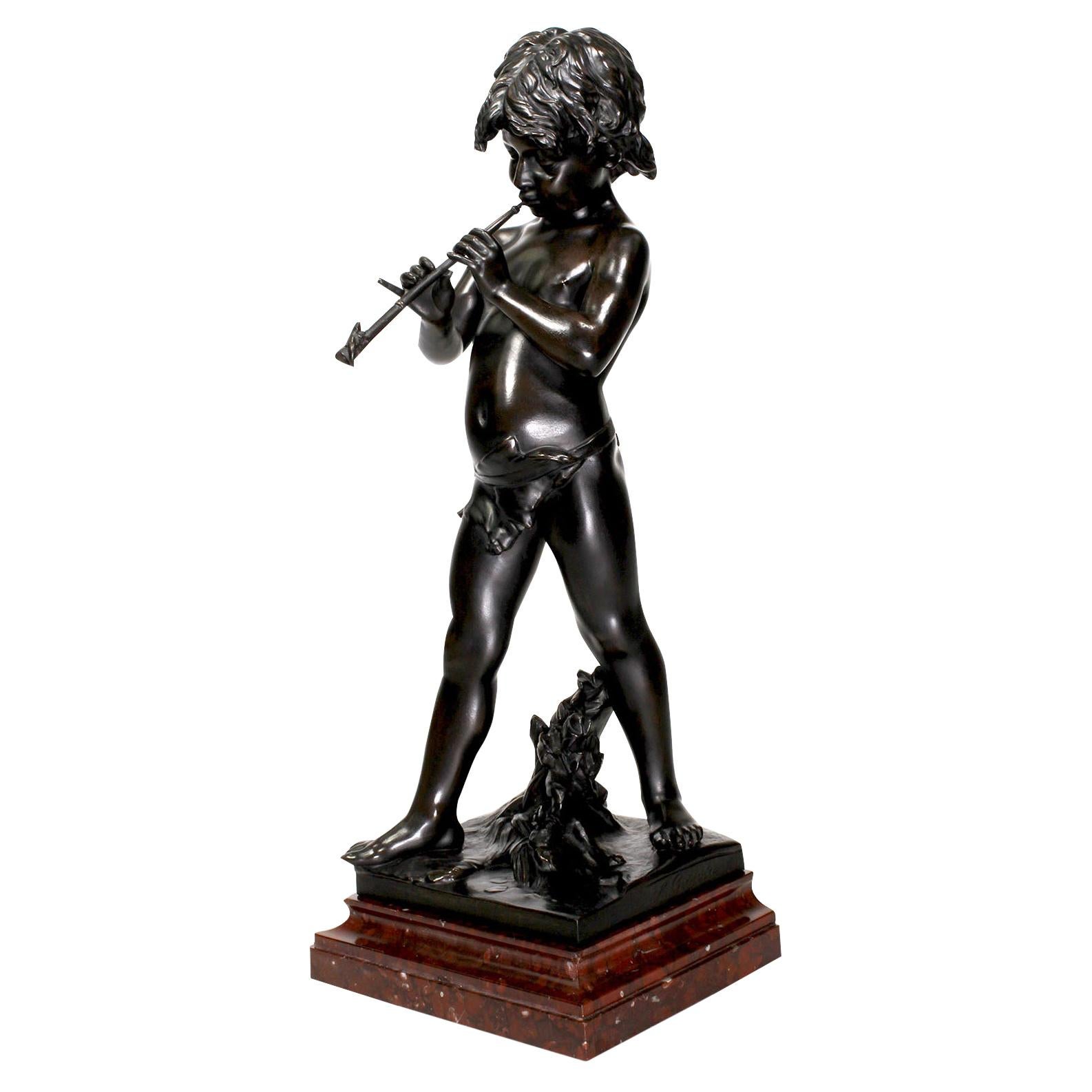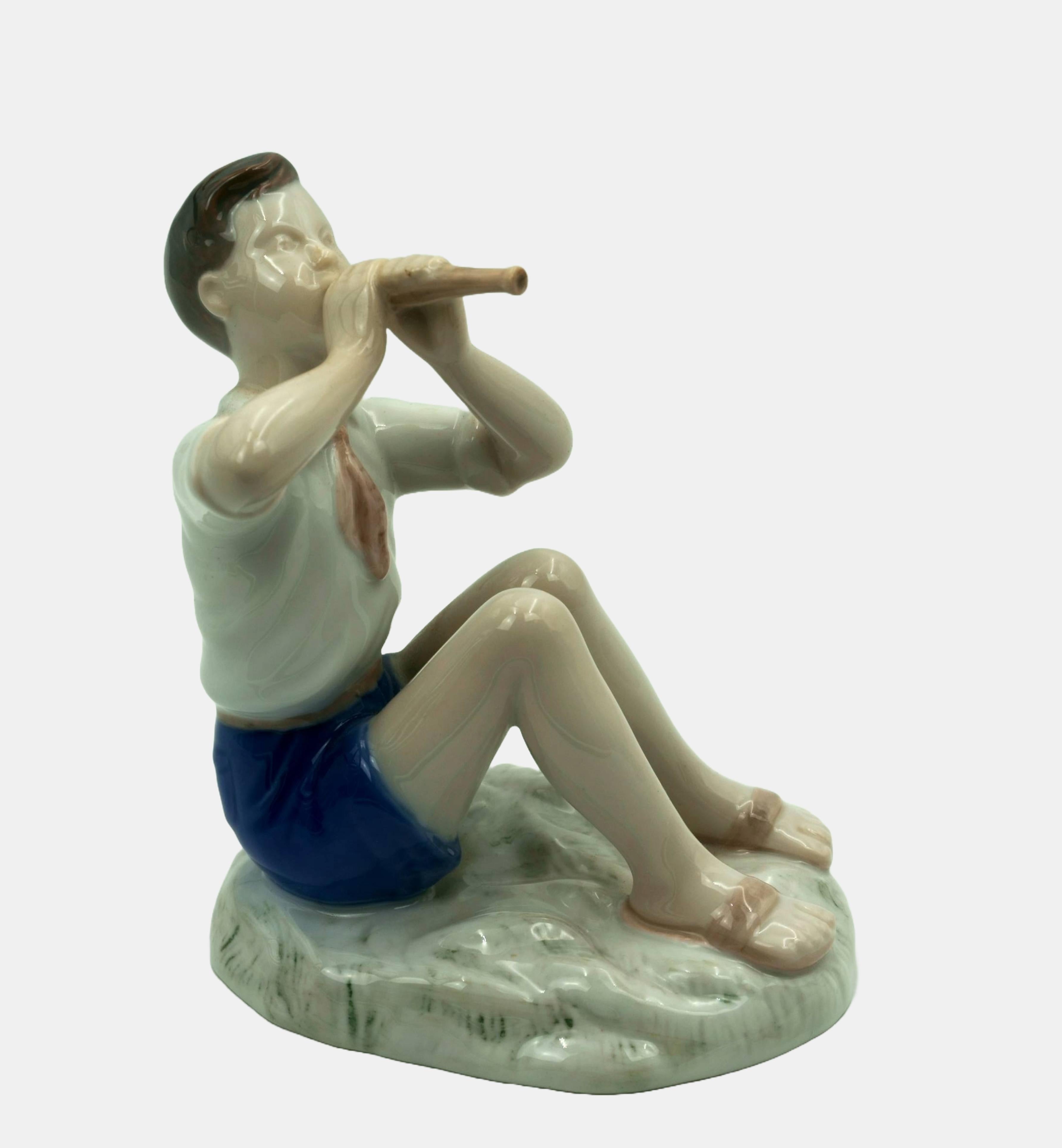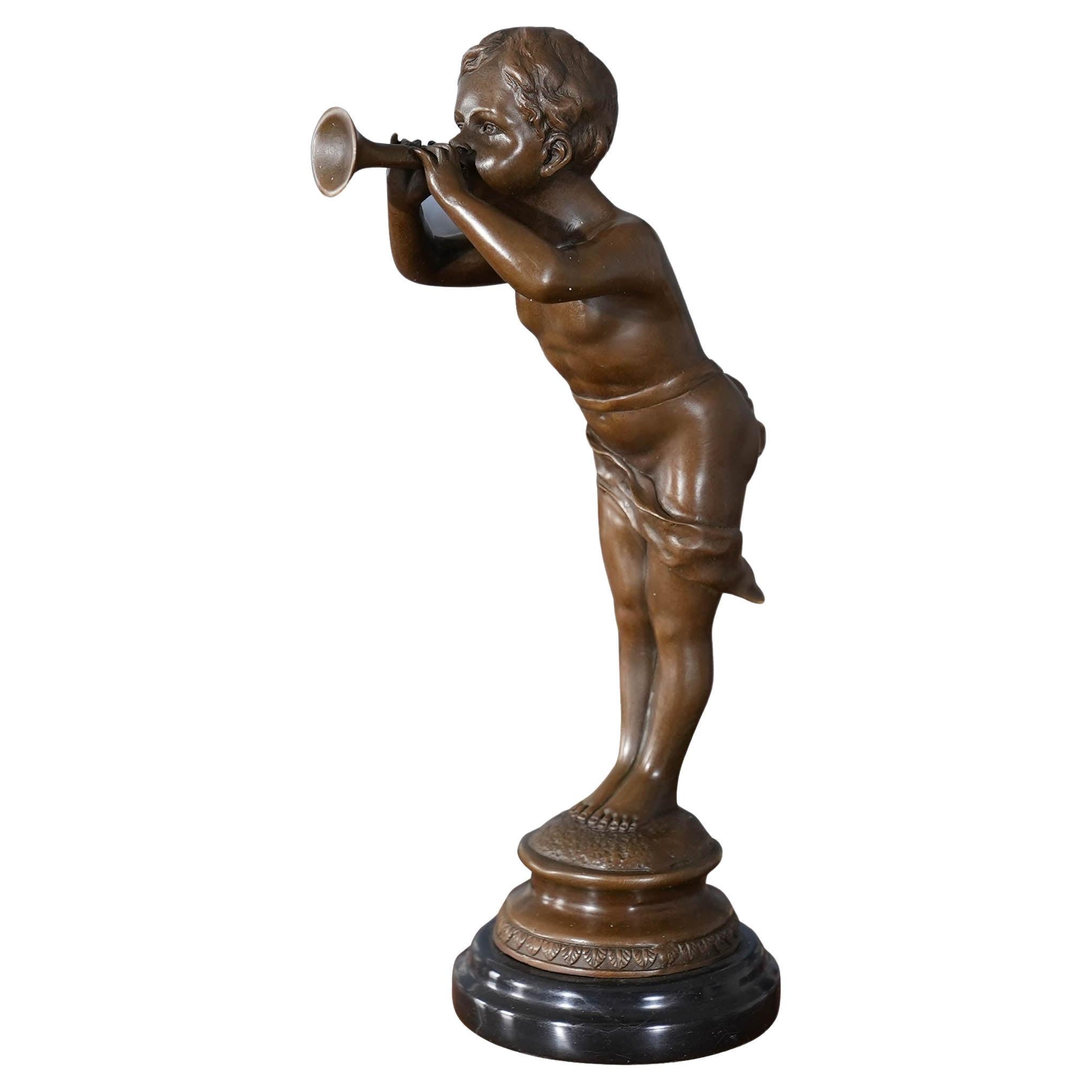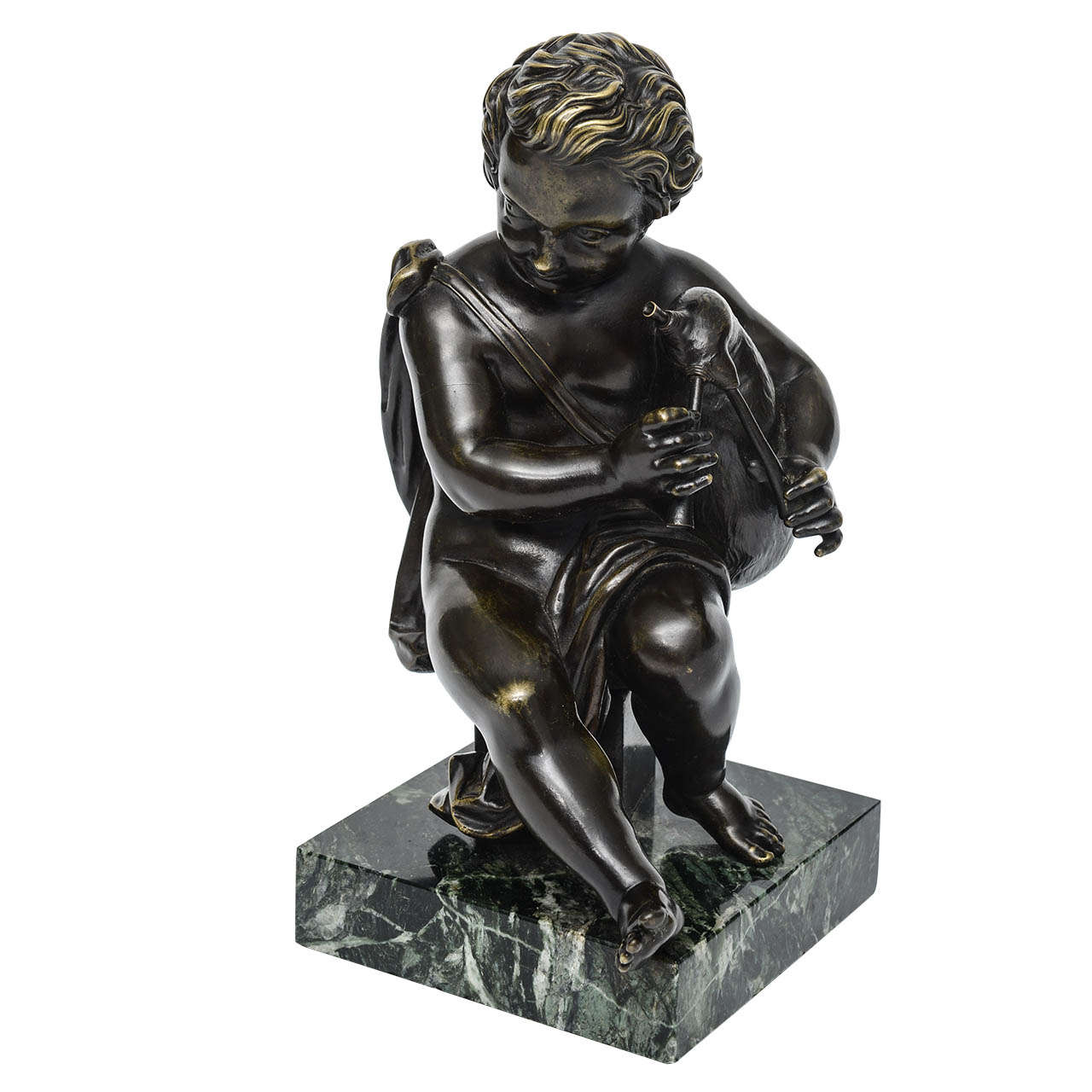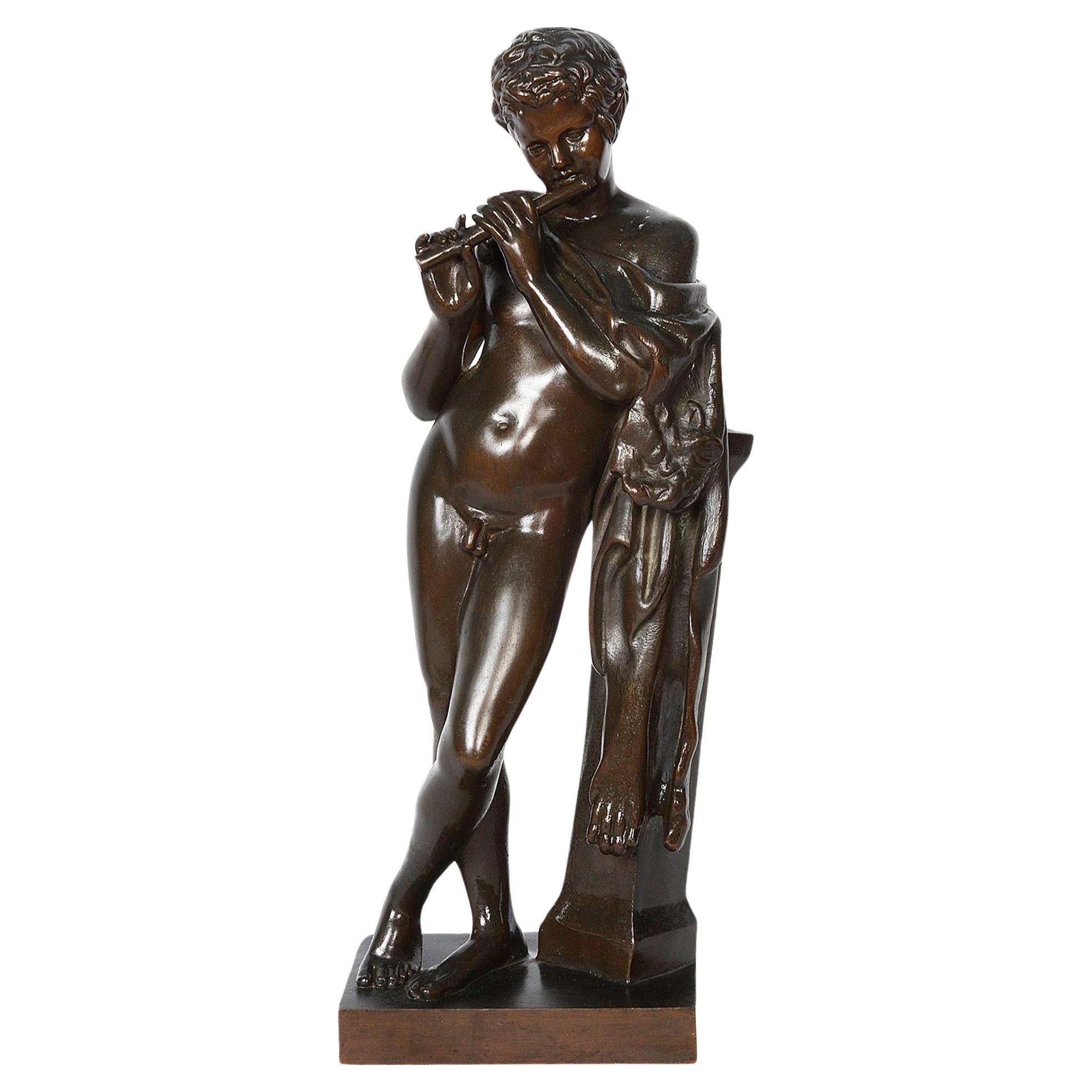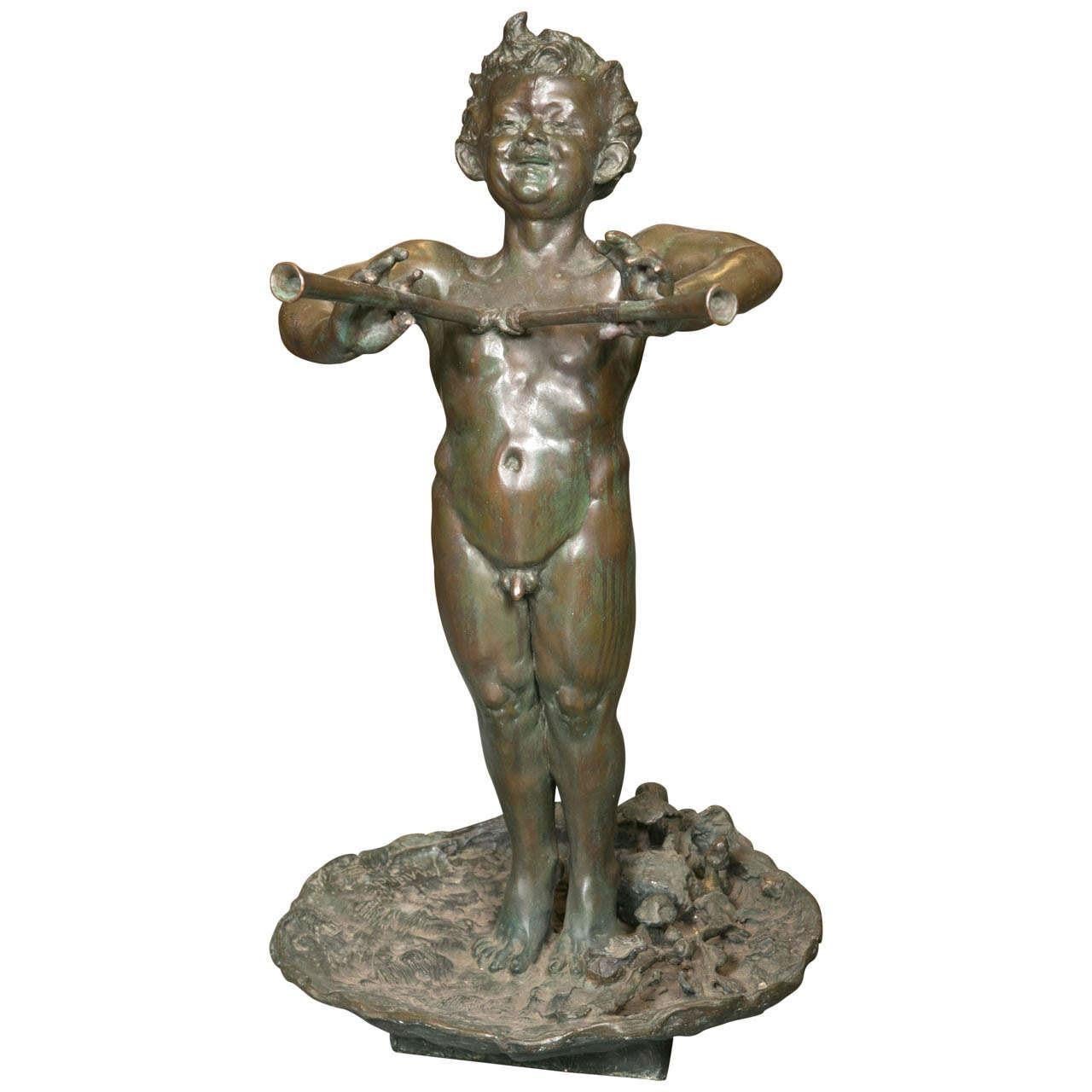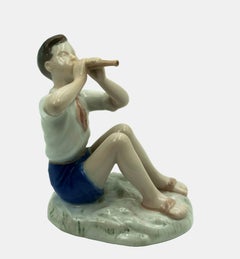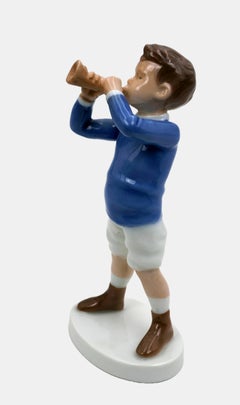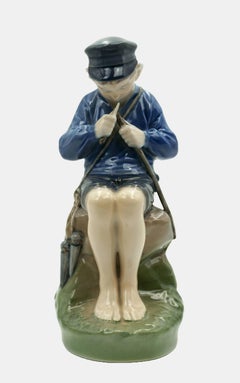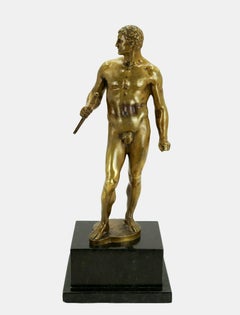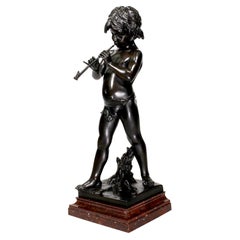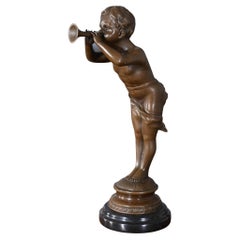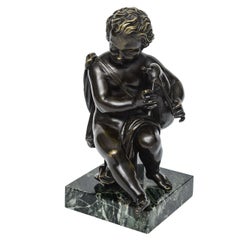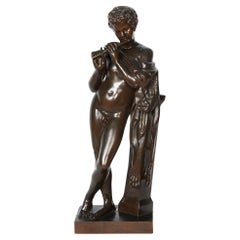Items Similar to Boy playing the shawm / - The transience of sounds -
Want more images or videos?
Request additional images or videos from the seller
1 of 10
Hans HardersBoy playing the shawm / - The transience of sounds -c. 1930
c. 1930
$2,108.02
$2,635.0320% Off
£1,562.16
£1,952.7020% Off
€1,760
€2,20020% Off
CA$2,877.85
CA$3,597.3120% Off
A$3,201.49
A$4,001.8620% Off
CHF 1,678.26
CHF 2,097.8320% Off
MX$39,121.44
MX$48,901.8020% Off
NOK 21,370.57
NOK 26,713.2120% Off
SEK 20,117.43
SEK 25,146.7920% Off
DKK 13,400.49
DKK 16,750.6120% Off
Shipping
Retrieving quote...The 1stDibs Promise:
Authenticity Guarantee,
Money-Back Guarantee,
24-Hour Cancellation
About the Item
Hans Harders (1875 Mörel - 1955 Berlin), Boy playing the shawm, around 1930. Dark patinated bronze with round plinth on a black marble base (2 cm high), total height 35 cm, diameter of the cast base 8 cm, weight 3.86 kg, foundry mark “Lauchhammer Bildguss” on the reverse of the plinth. Listed in the Lauchhammer catalogs as “Bildguss 26” designed by Hans Harders, unsigned.
- Slightly bumped in places, patina rubbed in places, especially on the back, upper edge of the marble base with minimal chipping, otherwise in good condition.
- The transience of sounds -
At first glance, the boy's natural appearance suggests that Hans Harders modeled him after a young boy. In fact, the artist was inspired by Donatello's famous putti playing music on the baptismal font in Siena Cathedral, which the Italian created in 1428. One of them, the tambourine-playing putto, has been in the Berlin Sculpture Collection since 1902. Harders obviously based the design of the limbs on the work of the Renaissance artist. Even the size corresponds to the model. And yet Harders has created an entirely unique work of art with a completely different expressive content.
The Berlin artist dispenses with the artificial yet natural-looking torsion of Donatello's putto and instead shows his boy in a motionless, upright pose. The dancing extroversion is transformed into an inner mood related to the music. The motionless position creates a correspondence between the body and the shawm. The boy is completely absorbed in the act of making music, which is also expressed physically, especially in the puffy cheeks of the face, which is conceived in a completely different way than Donatello's. Here, Harder studied baroque trombone-blowing angels, who also have a high forehead. In general, the whole body is a little fuller than Donatello's - in the manner of baroque putti - which is particularly evident in the folds of fat on the thighs. The larger body volume suits the music-making on the wind instrument and also lends the imagined notes a greater volume.
If, in Donatello's work, the putti of the Renaissance became children, although they remained winged, here we see a putto-like human boy in ancient nudity, to which Donatello also alludes. The shawm is a reminiscence of antiquity, of Virgil's shepherds' bucolic music heralding the happy Golden Age. Harder's boy, however, is not performing a joyous dance. Rather, he is completely immersed in the melody he has created, which displays a deeply melancholy quality that is not counteracted by the boy's figure, but rather intensified. The paradise from which he comes as a putto is lost. All that remains is to listen to the sounds that fade away, just as paradise itself has faded away. And yet music itself offers the soul a temporary home, because, as the then widely read philosopher Arthur Schopenhauer explains in his work The World as Will and Representation, it offers aesthetic salvation from the constant drive of an accelerating world.
About the artist
Hans Harder's artistic talent was already evident as a child, when he made animal figures out of clay. His parents, farmers from Mörel, encouraged their son's talent and enabled him to study at the art academies in Berlin and Dresden. Following his artistic roots as a sculptor, he became a sculptor and medalist. Based in Berlin, his bronze works were produced by the Rosenthal & Maeder foundry and later by Preiss & Kassler. From the 1920s he also created models for the porcelain manufacturers Fraureuth and Hutschenreuther.
GERMAN VERSION
Hans Harders (1875 Mörel - 1955 Berlin), Schalmei spielender Knabe, um 1930. Dunkel patinierte Bronze mit runder Plinthe auf schwarzem Marmorsockel (2 cm Höhe), Gesamthöhe 35 cm, Durchmesser des gegossenen Sockels 8 cm, Gewicht 3,86 kg, auf der Rückseite der Plinte Gießereimarke „Lauchhammer Bildguss“. In den Lauchhammer Katalogen als von Hans Harders entworfener „Bildguss 26“ angeführt, unsigniert.
- Vereinzelt etwas bestoßen, Patina insbesondere am Rücken stellenweise berieben, obere Kante des Marmorsockels mit minimalen Abplatzungen, sonst in gut erhaltenem Zustand.
- Die Vergänglichkeit der Töne -
Auf den ersten Blick wirkt es aufgrund des natürlichen Anscheins des Knaben, als ob Hans Harders ein Junge Modell gestanden hätte. Tatsächlich lässt sich der Künstler hier jedoch von Donatellos berühmten musizierenden Putten auf dem Taufbecken des Domes von Siena inspirieren, die der Italiener 1428 geschaffen hat. Einer von ihnen, der Tamburin spielende Putto, befindet sich seit 1902 in der Berliner Skulpturensammlung. Hinsichtlich der Gestaltung der Körperglieder orientiert sich Harders offensichtlich am Werk des Renaissancekünstlers. Selbst die Größe entspricht dem Vorbild. Und doch schafft Harders ein ganz eigenes Kunstwerk, das einen gänzlich anderen Ausdrucksgehalt aufweist.
Der Berliner Künstler verzichtet auf die artifizielle und dennoch natürlich wirkende Torsion von Donatellos Putto und zeigt seinen Knaben stattdessen in einer unbewegten aufrechten Haltung. Die tänzerische Extrovertiertheit wird in eine innerliche, auf die Musik bezogene Gestimmtheit überführt. Die Schlussstellung bewirkt eine Entsprechung des Körpers mit der Schalmei. Der Knabe geht ganz im Akt des Muszierens auf, der auch körperlich zum Ausdruck kommt und insbesondere den aufgeblähten Backen des ganz anders als bei Donatello aufgefassten Gesichts abzulesen ist. Hier wiederum hat Harders barocke Posaune blasende Engel studiert, die ebenfalls eine hohe Stirn aufweisen. Überhaupt ist der ganze Körper – barocken Putten entsprechend – etwas fülliger als bei Donatello, was insbesondere durch die Speckfalten an den Oberschenkeln augenfällig wird. Das umfangreichere Körpervolumen passt zum Muszieren auf dem Blasinstrument und verleiht auch den imaginierten Tönen ein größeres Volumen.
Werden mit Donatello die Putten in der Renaissance zu Kindern, die allerdings geflügelt bleiben, steht hier ein puttohafter menschlicher Knabe in antiker Nacktheit vor Augen, auf die sich auch Donatello bezieht. Die Schalmei ist ebenfalls eine Reminiszenz an die Antike, an Vergils vom frohen Goldenen Zeitalter kündende Hirtenbukolik. Harders Knabe vollführt aber keinen freudigen Tanz. Vielmehr ist er ganz in die von ihm selbst hervorgebrachte Melodie versunken und weist dabei einen tiefsinnig-melancholischen Zug auf, der durch die Knabengestalt nicht konterkariert, sondern noch verstärkt wird. Das Paradies, dem er als Putto selbst entstammt, ist verloren. Was bleibt, ist einzig den Tönen zu lauschen, die verklingen, wie das Paradies selbst verklungen ist. Und doch bietet die Musik selbst der Seele eine temporäre Heimstatt, da sie, wie es der seinerzeit viel gelesene Philosoph Arthur Schopenhauer in seinem Werk Die Welt als Wille und Vorstellung darlegt, eine ästhetische Erlösung aus dem beständigen Getriebensein einer sich beschleunigenden Welt bietet.
zum Künstler
Bereits als Kind zeigte sich Hans Harders künstlerisches Talent, indem er aus Lehm Tierfiguren formte. Die Eltern – Bauern aus Mörel – förderten die Begabung ihres Sohnes und ermöglichten ihm ein Studium an der Berliner und der Dresdener Kunstakademie. Seinen künstlerischen Wurzeln als Plastiker folgend, wurde er Bildhauer und Medailleur. In Berlin ansässig, führten die Bildgießereien Rosenthal & Maeder und später Preiss & Kassler seine Werke aus. Ab den 1920er Jahren schuf Harders zudem Modelle für die Porzellanmanufakturen Fraureuth und Hutschenreuther.
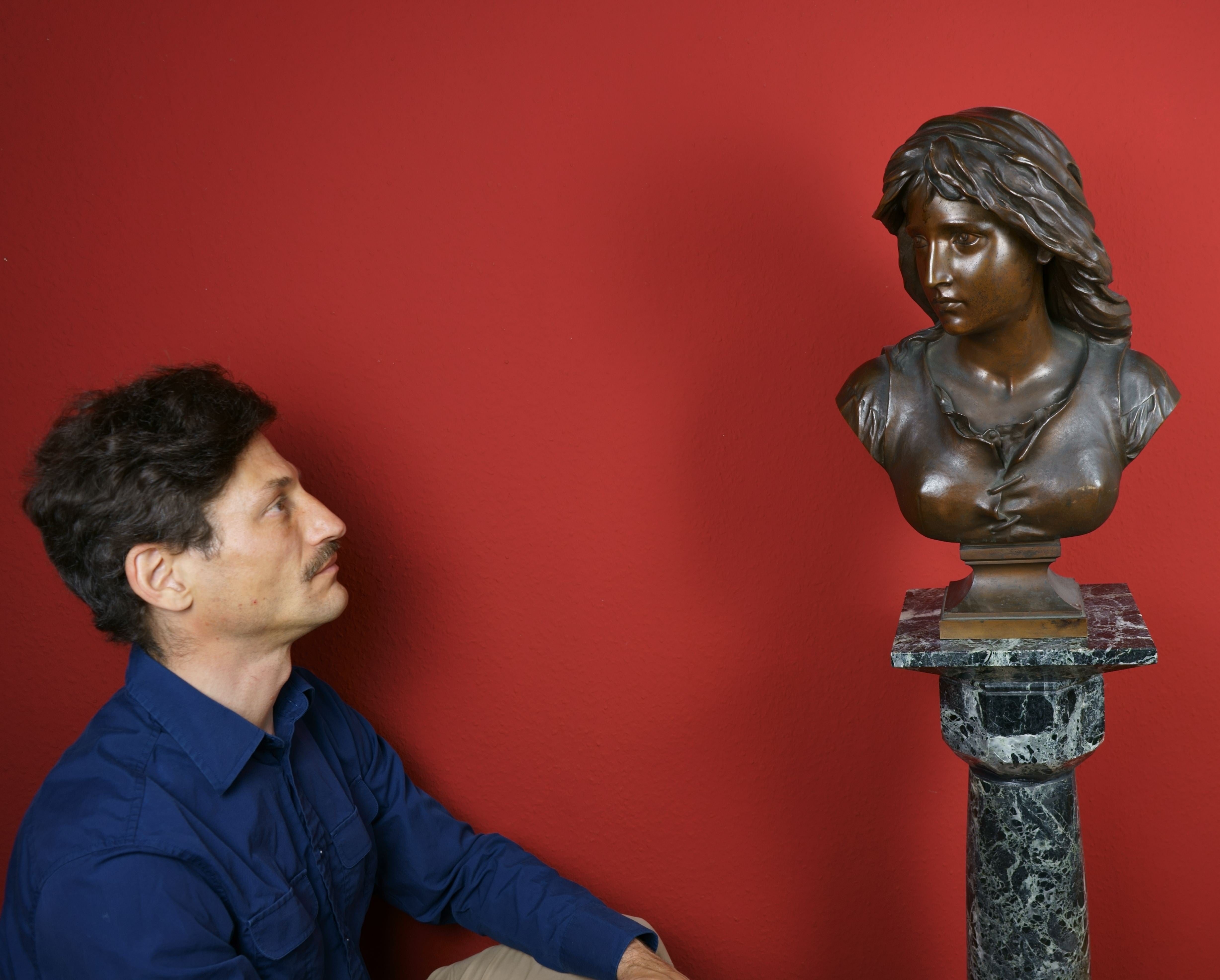
About the Seller
5.0
Gold Seller
Premium sellers maintaining a 4.3+ rating and 24-hour response times
Established in 2014
1stDibs seller since 2023
20 sales on 1stDibs
- ShippingRetrieving quote...Shipping from: Berlin, Germany
- Return Policy
Authenticity Guarantee
In the unlikely event there’s an issue with an item’s authenticity, contact us within 1 year for a full refund. DetailsMoney-Back Guarantee
If your item is not as described, is damaged in transit, or does not arrive, contact us within 7 days for a full refund. Details24-Hour Cancellation
You have a 24-hour grace period in which to reconsider your purchase, with no questions asked.Vetted Professional Sellers
Our world-class sellers must adhere to strict standards for service and quality, maintaining the integrity of our listings.Price-Match Guarantee
If you find that a seller listed the same item for a lower price elsewhere, we’ll match it.Trusted Global Delivery
Our best-in-class carrier network provides specialized shipping options worldwide, including custom delivery.More From This Seller
View AllBing & Grondahl Figure Boy playing the flute / - The lightness of tones -
Located in Berlin, DE
Vita Birgitte Thymann, Boy playing the flute, between 1952 and 1957. model number 2344. First choice. Porcelain with underglaze painting. 13 cm (height) x 11 cm (length) x 12 cm (dep...
Category
1950s Realist Figurative Sculptures
Materials
Porcelain
Bing & Grondahl Figure Standing boy with trumpet / - The Fanfare -
Located in Berlin, DE
Michaela Ahlmann, Standing boy with trumpet, made between 1970 and 1982, model number 1792, first choice. Porcelain with underglaze painting. 18.5 cm (height) x 8 cm (length) x 7 cm ...
Category
1970s Realist Figurative Sculptures
Materials
Porcelain
Royal Copenhagen Figure Carving Boy / - Immersed in concentration -
Located in Berlin, DE
Christian Thomsen (1860 Kolding - 1921 Copenhagen), Carving boy, design around 1915, execution 1966. model number 905. First choice. Porcelain with underglaze painting. 18.5 cm (heig...
Category
1910s Realist Figurative Sculptures
Materials
Porcelain
Naked warrior with short sword / - The New Hercules -
Located in Berlin, DE
Hermann Volz (1847 Karlsruhe - 1914 ibid.), Naked warrior with short sword, c. 1935. Partially (?) patinated bronze with cast plinth mounted on a black marble base (6.8 cm high). 32....
Category
1930s Art Deco Nude Sculptures
Materials
Bronze
Juggler / - Artistic naturalness -
Located in Berlin, DE
Claire Jeanne Robertine Colinet (1880 Brussels - 1950 Asnières-sur-Seine), Juggler, around 1920. Brownish patinated bronze with gilded balls on a round, multi-profiled stone base (10...
Category
1920s Art Deco Nude Sculptures
Materials
Bronze
Florentine singer / - The Renaissance of the Renaissance -
By Paul Dubois
Located in Berlin, DE
Paul Dubois (1829 Nogent-sur-Seine - 1905 Paris), Florentine singer, 1865. Light brown patinated bronze with cast round plinth mounted on a square marble base (3.5 cm high). Total height 53 cm. Bronze dimensions: 49.5 cm (height) x 20 cm (length) x 10 cm (width), weight 5.6 kg. Inscribed on the plinth "P.[aul] DUBOIS", dated "1865", with the foundry's mark "F. BARBEDIENNE FONDEUR" and the signet "REDUCTION MECANIQUE A. COLLAS".
- Patina very occasionally darkened, lute with loss of one tuning peg, otherwise in excellent condition.
- The renaissance of the Renaissance -
The bronze is a precisely executed and masterfully cast contemporary reduction of Paul Dubois 155 cm tall masterpiece "Florentine Singer", which is exhibited in the Musée d'Orsay and for which the artist was awarded the Medal of Honor at the Paris Salon in 1865. The work acted as a beacon, and was followed by a plethora of depictions of juveniles.
Inspired by Donatello and Luca della Robbia, but also by painters such as Piero della Francesca, Benozzo Gozzoli, and Pinturicchio, the "Florentine Singer" is not an epigonal work that pays homage to a vanished era, but a successful attempt to draw vitality from the art of the past and thus give it new life.
The effect of vitality is the core of Italian Renaissance art theory. In order to fulfill itself as art, art had to appear like nature. This naturalism also characterizes the "Florentine Singer". The young man appears to have been taken from life, which is reinforced by the momentary nature of his action. He has just struck a now fading chord. In addition, the natural appearance is enhanced by the detailed shaping of the figurative details, such as the laces with the slightly curved leather of the shoes, the belt buckle, or the ornamentation on the body of the lute. Even the fingernails are clearly defined. Unlike the Renaissance, however, the effect of liveliness here is not based on the "discovery" of nature and the human body, but primarily on the rediscovery of the art of the Quattrocento. The liveliness of the artwork is therefore at the same time a revitalization of this art, so that we can speak of a Renaissance of the Renaissance, just as the Pre-Raphaelites in England at the same time transferred the Quattrocento to contemporary art.
Dubois takes on the most difficult of all subjects, the depiction of singing through silent sculpture. He was preceded in this by Luca della Robbia and Donatello with their pulpits of singers created in the 1430s in the Museo dell'Opera del Duomo in Florence. Compared to these works, the physiognomy of Dubois singer is far less animated, yet he also depicts singing in a convincing manner. He uses the whole body. He takes the ancient contrapposto, which was essential to Renaissance sculpture, and transforms the standing leg-playing posture into a late medieval S-swing, giving the body an elegant beauty and at the same time setting it in melodic motion. In the equally elegant finger position, the music is expressed in a much more literal way with the beating of the lute. Finally, the musicality of the sculpture culminates in the face with the mouth open to sing.
Through the act of singing, which is a great challenge to the artistic will to depict perfect beauty, the gracefulness of the classical face is not diminished, but enhanced. Starting from the face with the singing mouth and the gaze absorbed by the sounds, the inner vitality spreads, giving the bronze sculpture an intense aura, enhanced by the music. Dubois transfers the beauty of the Renaissance to the musical, sublimating the visible sculpture to the invisible of music.
He took up the challenge of transcending the Renaissance with the Renaissance, thus responding to the Querelle des Anciens et des Modernes, which arose at the end of the 17th century around the French Academy and remained virulent into the 19th century, in which antiquity was regarded either as an unattainable ideal or as a standard to be surpassed. With his work, Dubois proved that the Renaissance, which had championed the art of the ancients, could lead to a new renaissance of art.
About the artist
Paul Dubois' great-uncle was the famous French Baroque sculptor Jean-Baptiste Pigalle, in whose footsteps the talented great-nephew followed. When he debuted at the Paris Salon in 1858, he signed his work "Dubois-Pigalle". At his father's request, however, he first studied law before devoting himself to sculpture under the tutelage of François Christophe Armand Toussaint in 1856 and entering the École des Beaux-Arts in 1858. From 1859 to 1863, he lived in Rome and traveled to Naples and Florence. Inspired by Florentine art of the quattrocento, Dubois initiated a school-forming neo-Florentine style that combined the elegantly simple forms of youthful grace with a precise wealth of detail.Two purchases by the French state (“envois de Rome”) were made during his stay in Rome, which brought him recognition in Paris. After his return there, he quickly became an internationally sought-after artist.
Dubois was also active as a creator of monuments. His most famous work is the equestrian statue of Joan of Arc (1896) on the forecourt of Reims Cathedral. He was also a sought-after portraitist who produced around 50 busts and - Dubois was also a passionate painter - around 100 portraits in oil.
From 1873 to 1878 he was curator of the Museum du Luxembourg, in 1876 he became a member of the Institut de France and from 1878 to 1905 he was director of the École des Beaux-Arts.
In 1865, Dubois was awarded the Paris Salon Medal of Honor for his “Florentine Singer”. In 1867 he became Chevalier, in 1874 Officier, in 1886 Commandeur of the Légion d'honneur, which awarded Dubois the Grande Croix in 1896.
Selected Bibliography
Stole, Elmar: Paul Dubois. In: Saur. Allgemeines Künstlerlexikon, vol. 30, Munich - Leipzig 2001, pp. 677-678.
GERMAN VERSION
Paul Dubois (1829 Nogent-sur-Seine - 1905 Paris), Florentinischer Sänger, 1865. Hellbraun patinierte Bronze mit gegossener runder Plinthe auf quadratischem Marmorsockel montiert (3,5 cm Höhe). Gesamthöhe 53 cm. Maße der Bronze: 49,5 cm (Höhe) x 20 cm (Länge) x 10 cm (Breite), Gewicht 5,6 kg. Auf der Plinthe mit „P.[aul] DUBOIS“ bezeichnet, auf „1865“ datiert, mit dem Gießereistempel „F. BARBEDIENNE FONDEUR“ und dem Signet „REDUCTION MECANIQUE A. COLLAS“ versehen.
- Patina sehr vereinzelt nachgedunkelt, Laute mit Verlust eines Stimmwirbels, ansonsten ausgezeichnet erhalten.
- Die Renaissance...
Category
1860s Realist Figurative Sculptures
Materials
Bronze
$4,311 Sale Price
20% Off
You May Also Like
After Jean Louis Grégoire Spelter Figure "Boy Playing Pipe"
By Jean Louis Grégoire
Located in Los Angeles, CA
After Jean Louis Grégoire (France, 1840-1890) A Charming French 19th-20th Century Patinated Spelter Figure of "The Animal Charmer", depicting a sta...
Category
Antique Early 1900s French Folk Art Figurative Sculptures
Materials
Marble, Spelter
$4,685 Sale Price
27% Off
Bronze Boy with Bugle on Marble Base
Located in Annville, PA
Graceful even when standing still the Bronze Boy with Bugle is a striking addition to any setting. Using traditional lost wax casting methods the Bronze Boy...
Category
2010s Abstract Sculptures
Materials
Bronze
$305 / item
Bronze Figure of Young Boy Playing the Bagpipe, French, 19th Century
By Jean-Baptiste Pigalle
Located in Miami Beach, FL
After Jean-Baptist Pigalle (1736-1785) a French sculptor renown for his designs of children at play.
Mounted on a new green marble base.
Category
Antique 19th Century French Neoclassical More Furniture and Collectibles
Materials
Marble, Bronze
$720 Sale Price
74% Off
19th Century Bronze Faun playing a flute.
Located in Brighton, Sussex
A very good quality 19th century patinated bronze figure featuring the satyr Marsyas playing the flute. He is standing against a column, partially covered with his own skin, which re...
Category
Antique Late 19th Century Figurative Sculptures
Materials
Bronze
Mid 20th Century Bronze Statue Boy with Flutes, M. A. Aldrich
Located in Stamford, CT
Signed by M.A. Aldrich. This statue of a bronze young man is standing in a lily pad with wildlife surrounding his feet. A turtle and other water creatures can be seen on pad.
This is...
Category
Mid-20th Century American Statues
Materials
Bronze
Pan Playing The Flutes, Neoclassical Sculpture
Located in Palm Springs, CA
A nice metal sculpture of Pan playing his pipes or flutes. neoclassical grand tour sculpture after the antique. This beautifully cast and finished example is mounted on a round marbl...
Category
20th Century Italian Figurative Sculptures
Materials
Metal, Brass
More Ways To Browse
Art Plinth
Marble Sculpture Nude
Art Deco Sculpture Nude
Art Deco Berlin
Art Deco Bronze Nude
Black Bronze Nudes
Art Deco Bronze Sculpture Nude
Bronze Nude Dancer
The Good Shepherd
Fat Sculptures
Boy Sculpture Marble
Putto Sculpture
Art Deco Sculpture Face
Farmer Sculpture
1920s Dancer Sculptures
Marble Nude Vintage Sculpture
Putti Angels
Angel Art Deco
